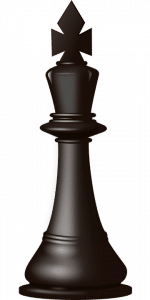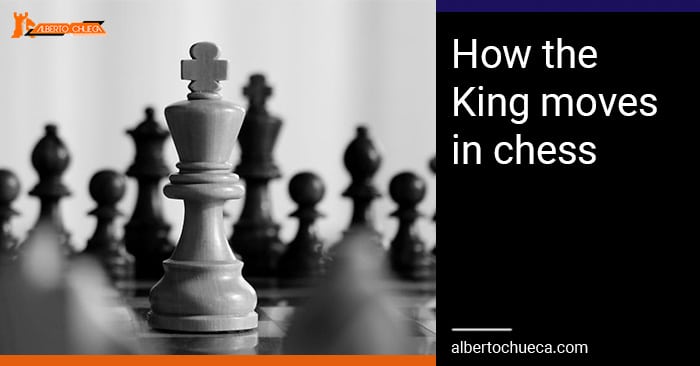Table of Contents
How does the King move in chess?
The King is the most special piece on the board. Learning how the King moves in chess is critical. In the simple sense that if the King is “captured”, the game is essentially over! It would be easy to describe the King's functioning in a sentence or two… but it's a very significant piece, so why not devote an entire article on how the King moves in chess? :)

The Chess King's Looks
As you can see, the King simply a figure with a cross on top, to represent its royalty. The King can humorously be criticized for being the most important piece on the board, but the least functioning, as we will learn with how the King moves in chess. However, when you really think about it, in the medieval times of Kings and Queens, was the King armed with a sword/shield and risking his life fighting the battles? I don't think so. However, as the Queen is the most valuable piece on the chessboard which is our fictional battlefield, I don't believe the medieval times Queen was fighting these battles either!

The Chess King's starting position
This is one of the first questions we should answer. As all of the major pieces are on the back rank, the King and Queen start out in the middle two squares on the back rank. The King starts on the right, the Queen on the left.
We see above, as mentioned, the King is on the right, Queen on the left, and the other pieces (Bishop, Knight, Rook, etc) follow, obviously with the pawns in front.
How the King moves in chess?
The King's movements are quite simple, and as mentioned earlier, quite immobile. He can simply move one square in any direction he wants.
As you can see above, the King has the ability to move in any direction one square, left, right, up, down, or diagonal. It can be a sneaky powerful piece in the endgame, as he can slide in any direction possible. However, in the middlegame, the focus is on pawns, rooks, bishops, knights, and queens. As we will mention below, the King must be protected in the opening and middlegame.
Let's talk about check and checkmate
After we learn about how the King moves in chess, we must learn about some of the necessary rules pertaining to the King. One common rule that disappoints a lot of beginner chess players is that you never actually capture, or take the King off the board. You have to checkmate the King. Before we talk about checkmate, we will talk about check. Checking the opposing King is when you attack (threaten to capture) the opposing King. When the King is in check, he is obligated to move.
The Rook on g7 is threatening to capture the King on b7. Since there is no King-capturing in the game of chess, the King is obliged to move. Since he can move, there is no checkmate in the position. If he were not able to move, checkmate would result.
In the situation above, the two Rooks work together to take all of the squares away from him with how the King moves in chess. Checkmate occurs as a result.
How the King moves in chess: Strategies
We have talked about what the King as well as the rules. But how should we properly utilize the King? As we have mentioned in the past, if the King is checkmated, the game is over. As all of the action generally goes on in the center of the board, it's not a good strategy to leave the King in the center! We teach beginners the opening principles are to control the center, develop pieces, and get their King safe, almost always by castling. Remember that in chess, castling is when the King and Rook switch places, the King moves two squares towards the Rook, the Rook flips to the other side, landing right next to the King.
Some good opening moves we teach beginners are 1. e4, e5 2. Nf3, Nc6 3. Bc4, Bc5 4. O-O.
The center is under control, White has a few pieces out, and there we go… our King has retreated to safety!
How about in the endgame?
While we keep the King away from the action in the opening and middlegame, the endgame is when the King really gets to shine! This is because in the endgame, there are far fewer pieces on the board, so the chances that the King gets checkmated in the middle of the board are far and few. Therefore, in the endgame, the King is basically another piece we can use, so he should embrace the action on the board!
The position above is a classic example. Material is equal, Black to move. The Black King is already active, the White King is not. So we can see this as if Black is up a piece! Black ended up winning the game with Kc4-Kb3, infiltrating with the King. How the King moves in chess can be critical to our overall chess strategies.






